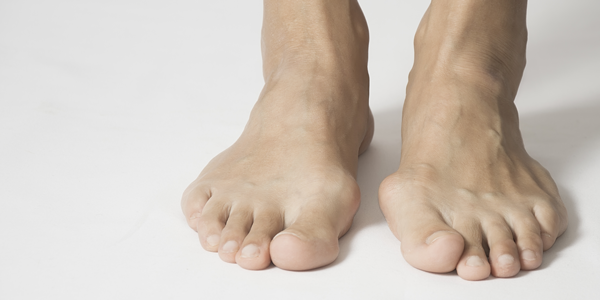
Also called a hallux valgus, a bunion is characterized by a deformity and deviation of the big toe and the big toe joint, also known as the first metatarsophalangeal joint (MTP joint). Knowing how to find the proper treatment for bunion pain can be difficult.
Natural biomechanics and/or poor-fitting footwear can cause bunions. For example, wearing high heeled shoes regularly can contribute to the development of bunions.
Whether you have high or low arches, it’s important to know that all foot types can be equally susceptible to developing bunions.
Treatment For Bunion Pain
Bunions are not always painful and the mobility around the joint can vary from stiff to quite flexible. However, if you are experiencing pain and stiffness from a bunion, there are a variety of methods that can provide effective treatment for bunion pain.
1. Proper Footwear
Not all shoes are created equally.
Footwear with a narrow and tapered toe box contributes to bunion growth by forcing the big toe inward and creating friction along the inside of the big toe joint. Wearing high heels can increase this pressure significantly; when you wear heels, you transfer your body weight onto your forefeet.
Look for footwear with a wider toe box. This will give your toes space to move around naturally and will also decrease inflammation caused by chafing.
Bunions can also be highly sensitive. Look for footwear with seamless uppers and soft leathers, as these can help reduce pressure points and irritation.
Unfortunately, no single shoe will work for everyone’s foot. A fitting expert can help you find the right type of footwear for your specific foot type and activity needs.
2. Custom Orthotics
Your foot type and natural biomechanics play a part in how susceptible you are to developing bunions. Custom orthotics help correct alignment issues that allow bunions to develop. They also slow down the progression of bunion development by accommodating your biomechanical needs.
With a flexible overpronated foot, orthotics will support and re-align the foot structure and reduce the pressure on the inside of the first MTP joint. With a rigid under pronated foot, orthotics will distribute weight throughout the foot and reduce the pressure building up in the forefoot.
Orthotics can also assist with pain relief depending on the severity of the bunion growth and hallux valgus/rigidus. (Kunnasegaran & Thevendran, 2015)
At Walking Mobility Clinics, we consider your alignment, your gait and your lifestyle when we create custom orthotics to meet all your biomechanical needs.
3. Splints & Toe Spacers
Bunion splints are designed to realign the big toe. They can also improve flexibility and prevent compression of the lesser toes. This works best if your toe is still flexible and can be pulled into correct alignment. Splints don’t help as much if your toe joint is rigid.
Because they don’t fit into most shoes, splints are often worn at night. However, there are models with a pivoting joint that move along with your foot.
It is important to note that wearing a bunion splint will not reduce bunion growth. However, it can slow its progression.
While they don’t provide the same type of stretch as splints, toe spacers can be worn during the day inside your shoes to prevent the big toe from chafing against the second toe. However, you must be sure that your shoes have enough room to accommodate toes spacers. You should add toe spacers without causing your bunion to rub against the inside of the shoe even more.
4. Ice
Applying ice to the big toe joint of the foot is a simple way to ease the pain at home. Ice helps fight inflammation by constricting the blood vessels and relieving swelling.
If you are experiencing pain caused by inflammation, try using a cold pack. Apply ice to the bunion area for 5-10 minutes at a time. Wrapping an ice pack in a thin towel can help prevent skin irritation while you ice your foot.
5. Pain-Relieving Creams
If you want to try another at-home remedy to relieving inflammation, applying an analgesic cream to the bunion area can help.
Analgesic creams, such as P3 Cream, feature anti-inflammatory ingredients such as calendula, an extract from the marigold flower.
Talk To A Specialist!
For more information about conservative treatment for bunion pain, visit a Walking Mobility Clinic location near you today!
